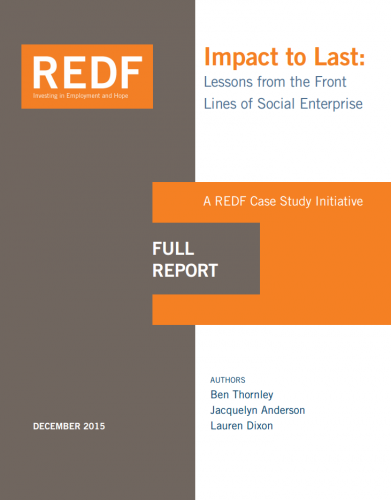Social enterprises—mission-driven businesses that break down barriers to employment—represent a cost-effective investment for society. For every dollar social enterprises spend, they return $2.23 to society, including $1.31 to taxpayers from reductions in government benefits and increases in revenues.2 There are literally thousands of social enterprises scattered throughout the U.S., of which the 10 profiled in this report represent a small fraction. Within this group alone, diverse business lines encompass everything from janitorial and groundskeeping to recycling, printing, warehousing and fulfillment, product manufacturing, and retail sales, working out of 11 states.
These enterprises create entry-level jobs for employees—sometimes permanent, but usually transitional—and, by supporting workers, provide both economic opportunity and the hard and soft skills training that can be transformational for individuals, their families, and the community. This is why the question of scale looms large.
Download Impact to Last
The presence of more and larger social enterprises benefits society, better addressing the needs of people who are economically disadvantaged and have been homeless; young adults disconnected from work and school; people formerly incarcerated; and those affected by addiction, mental illness, or other disabilities. The challenges of growing social enterprises are as real as the employment barriers their employees face. These businesses are often smaller organizations with limited access to capital (many are nonprofits). In their efforts to provide products and services of the highest quality, they balance market demands with the additional responsibilities and expenditures related to providing social supports, track evidence of impact for investors, and forge cross-sector relationships.
The 10 case studies highlighted in this report are not intended to provide a definitive guide to growing individual social enterprises, but rather to shed light on the question of how specific organizations have grown and flourished. The case studies are distinct, dynamic stories of perseverance, adaption, and innovation, including many critical lessons on the concrete practices and strategies that have enabled organizations with over 300 years of combined operational experience to balance mission and margin, at scale.These case studies reveal a compelling alignment of core drivers of success: a set of five common practices and inputs on the journey to achieving scale. By emphasizing these drivers, Impact to Last highlights the ingredients necessary for success at a field level and challenges advocates and other key stakeholders—including business leaders, public officials, and funders—to focus more intentionally on creating the conditions for growth in social enterprise.
| About REDF | |
| About Impact to Last | |
| Foreword | |
| Overview | |
| I: Introduction and Background | |
| Social Enterprise: Definitions and Approaches | |
| What “Does Achieving Scale Mean”? | |
| The Impact to Last Project | |
| The 10 Social Enterprises | |
| Program Models | |
| The Impact of Social Enterprise | |
| II. Core Drivers of Success | |
| Anchors | |
| Audacity | |
| Evidence | |
| Growth Capital | |
| Identity | |
| III. Emerging Drivers | |
| Social and Policy Innovation | |
| Collective Action | |
| Intermediary Engagement | |
| IV. The Road Ahead: Breaking Through | |





